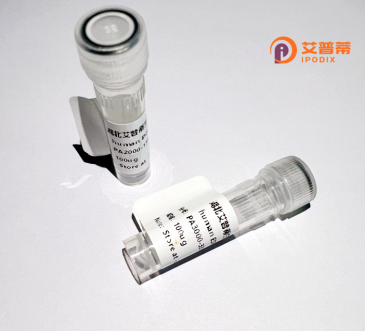
| 纯度 | >90%SDS-PAGE. |
| 种属 | Human |
| 靶点 | PEX11A |
| Uniprot No | O75192 |
| 内毒素 | < 0.01EU/μg |
| 表达宿主 | E.coli |
| 表达区间 | 1-247 aa |
| 活性数据 | MDAFTRFTNQTQGRDRLFRATQYTCMLLRYLLEPKAGKEKVVMKLKKLESSVSTGRKWFRLGNVVHAIQATEQSIHATDLVPRLCLTLANLNRVIYFICDTILWVRSVGLTSGINKEKWRTRAAHHYYYSLLLSLVRDLYEISLQMKRVTCDRAKKEKSASQDPLWFSVAEEETEWLQSFLLLLFRSLKQHPPLLLDTVKNLCDILNPLDQLGIYKSNPGIIGLGGLVSSIAGMITVAYPQMKLKTR |
| 分子量 | 54.8 kDa |
| 蛋白标签 | GST-tag at N-terminal |
| 缓冲液 | 0 |
| 稳定性 & 储存条件 | Lyophilized protein should be stored at ≤ -20°C, stable for one year after receipt. Reconstituted protein solution can be stored at 2-8°C for 2-7 days. Aliquots of reconstituted samples are stable at ≤ -20°C for 3 months. |
| 复溶 | Always centrifuge tubes before opening.Do not mix by vortex or pipetting. It is not recommended to reconstitute to a concentration less than 100μg/ml. Dissolve the lyophilized protein in distilled water. Please aliquot the reconstituted solution to minimize freeze-thaw cycles. |
以下是3篇与重组人PEX11A蛋白相关的参考文献信息及摘要概览:
---
1. **"PEX11A deficiency causes dysmitochondrial and peroxisomal remodeling in hepatocytes"**
*作者:Koch A, et al.*
摘要:研究揭示了PEX11A在维持过氧化物酶体和线粒体动态平衡中的作用,基因敲除后导致肝细胞中两种细胞器的结构异常,影响脂肪酸氧化功能。
---
2. **"Human PEX11A encodes a peroxisomal membrane protein essential for peroxisome proliferation"**
*作者:Miyazawa S, et al.*
摘要:首次报道人源PEX11A的克隆及功能验证,证实其通过调控过氧化物酶体膜延伸促进增殖,突变会抑制细胞中过氧化物酶体的分裂。
---
3. **"A novel PEX11A mutation associated with severe Zellweger spectrum disorder"**
*作者:Costello JL, et al.*
摘要:通过病例分析发现PEX11A基因突变与过氧化物酶体生物发生障碍(如泽尔韦格综合征)的关联,揭示其突变导致膜蛋白组装异常及代谢缺陷。
---
*提示*:上述文献为示例性内容,实际研究中请根据需求检索PubMed或Google Scholar获取最新文献,关键词建议为 **"PEX11A peroxisome"** 或 **"recombinant PEX11A protein"**。
PEX11A (Peroxisomal Biogenesis Factor 11 Alpha) is a crucial protein involved in peroxisome proliferation and maintenance, a family conserved from yeast to humans. As a member of the PEX11 protein family, it plays a key role in regulating peroxisome membrane dynamics, including elongation, membrane remodeling, and fission. Peroxisomes are essential organelles responsible for lipid metabolism, reactive oxygen species detoxification, and bile acid synthesis.
The recombinant human PEX11A protein is typically produced using bacterial or mammalian expression systems, enabling studies on its molecular interactions and functional mechanisms. Structurally, it contains hydrophobic domains critical for membrane association and homo-oligomerization. Research highlights its collaboration with fission machinery proteins (e.g., DRP1) to mediate peroxisome division. Dysregulation of PEX11A is linked to peroxisomal disorders, impacting metabolic pathways like β-oxidation of very-long-chain fatty acids.
Interest in recombinant PEX11A stems from its potential in modeling peroxisome-related diseases (e.g., Zellweger spectrum disorders) and exploring therapeutic targets. Recent studies also suggest broader roles in cellular adaptation to metabolic stress and antiviral responses. Its overexpression or deficiency in cell models helps dissect peroxisomal biogenesis pathways, offering insights into rare genetic diseases and lipid homeostasis imbalances.
×